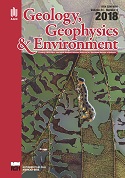Quantifying the uncertainty in the ultimate recoverable oil reserves using the Monte Carlo simulation techniques from ‘OWA’ Marginal Field, Onshore Niger Delta, Nigeria
DOI:
https://doi.org/10.7494/geol.2018.44.4.401Keywords:
marginal field, EUR, Monte Carlo, stochastic estimates, reserveAbstract
A review on the development of marginal oil fields in Nigeria has now become an important strategic issue if it is to remain amongst the top producers in the global market, and these fields are vast, available all over the Niger Delta. One of the factors that makes a field marginal is the size of its reserves. Stochastic estimation gives a certainty in terms of the possible number of outcomes within the range of input parameters. In this work, four (4) deviated wells and 3D seismic volume (362 inlines and 401 traces) were interpreted for the evaluation of the field. The petrophysical evaluations were interpreted using the Power Log software and the Seismic, Geographix and Petrel softwares. Stochastic reserve estimation was done using Monte Carlo sampling techniques and subjected to uncertainty quantification using the Crystal Ball software by varying distributions and measuring sensitivity impact on the overall reserves. The production profile was predicted based on some assumptions and history matching which result in the overall Expected Ultimate Recovery (EUR). The petrophysical analysis shows the reservoirs to be within the unconsolidated continental Benin Formation denoted as ‘Intra-Benin’ sands, an unconventional reservoir as supposed the normal reservoir rocks within the Agbada Formation. This indicated high porosity (0.28), water resistivity (7 Ω∙m), and water saturation and also inferred Heavy Oil (low API). Nine hydrocarbon sands were identified but only three (B1, D and E), representing shallow, mid and deep reservoirs were further evaluated. 1P and 2P reserve estimates were 4.8 MMBO and 5.7 MMBO for B1; 15.2 MMMscf and 16.4 MMMscf for D; 8.4 MMMscf and 8.8 MMMscf for E respectively. The Monte Carlo simulation of 1,000,000 trials with mainly triangular distribution assumption generated P10, P50, P90 were 6.5 MMBO, 5.6 MMBO and 4.4 MMBO for B1; 17.5 MMMscf, 13.7 MMMscf and 10.8 MMMscf for D; 10.4 MMMscf, 8 MMMscf and 6.1 MMMscf for E respectively. The sensitivity impact of the input parameters were estimated and ranked, and the coefficient of variability ranges within 15% to 20% for the reservoirs indicating that there is a very low level uncertainty of reserve estimation around the P10, P50 and P90 percentiles which could be positive for investment decisions. ‘OWA’ marginal field reflects a typical low reserve (EUR) category found within the Niger Delta basin.Downloads
References
Avbovbo A.A., 1978. Tertiary Lithostratigraphy of the Niger Delta. American Association of Petroleum Geologists Bulletin, 62, 295–300.
Awotiku O.I., 2011. Quantification of Uncertainty and Risks for Developing Marginal Fields in the Niger Delta. The Department of Petroleum Engineering, African University of Science and Technology [M.Sc. thesis, unpublished].
Bickel J.E. & Bratvold R.B., 2008. From uncertainty quantification to decision making in the oil and gas industry. Energy Exploration & Exploitation Journal, 26, 311–325.
Doust H. & Omatsola E., 1990. Niger Delta. [in:] Edwards J.D. & Santogrossi P.A. (eds.), Divergent/passive Margin Basins, AAPG Memoir, 48, American Association of Petroleum Geologists, Tulsa, 239–248.
Egbogah E.O., 2011. Onshore/Marginal Field Developments: Challenges, Opportunities and Prospects for the Future. [Presented at:] 2011 SPE Annual Oloiribi Lecture and Energy Forum, Lagos, Nigeria.
Kulke H., 1995. Nigeria. [in:] Kulke H. (ed.), Regional Petroleum Geology of the World. Part II: Africa, America, Australia and Antarctica, Gebrüder Borntraeger, Berlin, 143–172.
Short K.C. & Stauble J., 1967. Outline geology of the Niger Delta. American Association of Petroleum Geologists Bulletin, 5, 761–779.
Tuttle M., Charpentier R. & Brownfield M., 1999. The Niger Delta Petroleum System: Niger Delta Province, Nigeria, Cameroon, and Equatorial Guinea, Africa. United States Geologic Survey.
Downloads
Published
Issue
Section
License
Authors have full copyright and property rights to their work. Their copyrights to store the work, duplicate it in printing (as well as in the form of a digital CD recording), to make it available in the digital form, on the Internet and putting into circulation multiplied copies of the work worldwide are unlimited.
The content of the journal is freely available according to the Creative Commons License Attribution 4.0 International (CC BY 4.0)










